
JANE BURN – POETRY AS HARD GRAFT, INSPIRATION, REACTION OR EXPERIMENT?
I interviewed poet & artist Jane Burn who won the Michael Marks Environmental Poet of the Year 2023-24 with A Thousand Miles from the Sea.
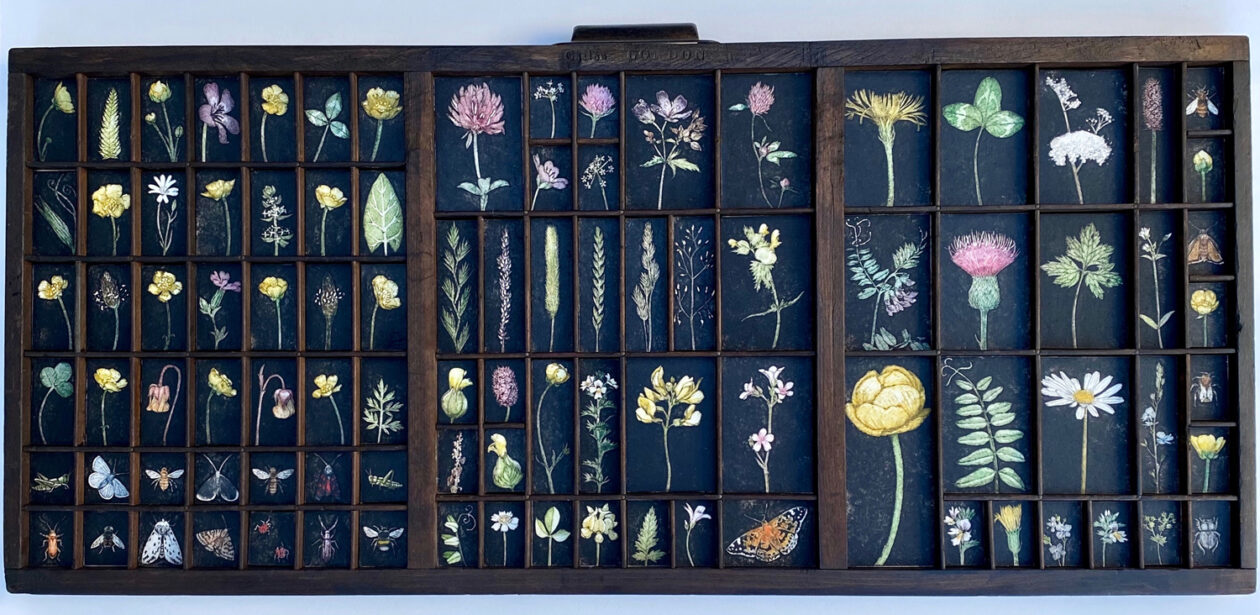
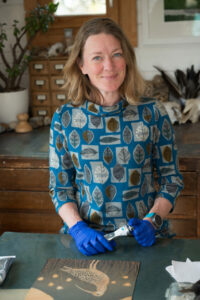
I interviewed printmaker Hester Cox whose colourful and richly textured collagraph prints are often inspired by things seen while out fellrunning. Hester says of her work: “By using multiple plates, painted textures and intricate cutting in my printmaking I can accentuate the patterns that I find in the natural world, celebrate the colours found in nature and draw attention to the everyday occurrences that happen around us but that often go unnoticed or are soon forgotten.”
Leslie: Given that you work in N. Yorkshire, is there a connection between your childhood and the art you make?
Hester: I was born and brought up in Reading in Berkshire so North Yorkshire is not the place of my childhood and I didn’t visit Yorkshire until I was in my twenties. However, a lot of my childhood was spent in nature. My mum was always interested in nature conservation and when she was in her 40s, she studied for a zoology degree and then a phd. She went on to become an ecological consultant and my childhood memories are of nature watching with her and my dad, looking for birds and animals, pond-dipping and identifying flowers, lichens, fungi and mosses. She collects natural objects and has passed that hobby onto me so that my studio is filled with stones, bones, feathers and fossils. I feel that my interest in natural history and wildlife has been nurtured by my parents over many years. Wherever I have lived, I have sought out the natural landscape and made work about the things that I’ve found there but where I live now is where I feel the most at home.
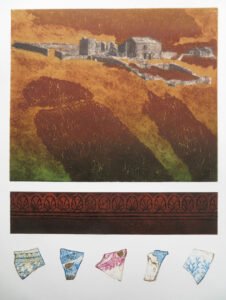
I’ve never really had a strong sense of belonging before. I’ve spent nineteen years growing up in Berkshire, three years at college in Harrow and then I moved to Leeds to live with my boyfriend of the time. When we split up, I travelled around the world on and off for eighteen months and then came back to live in North Yorkshire. It was only when I moved to Horton-in-Ribblesdale that I felt truly connected to the landscape around me. I think perhaps it is because I know it so well through my running. I’ve explored the area around me in fine detail and I know where to look for different animals and plants, what seasons to find specific species and when migrating birds will return. It is a very comforting feeling to be so connected to a place.
Leslie: Can you explain how you make your prints, please? How does the print process shape the artistic outcomes of your work?
Hester: I start off with an idea that is usually inspired by something I’ve seen when I’ve been out walking or running in the hills. I use sketches and my own photographs for reference, and a good deal of artistic license, when designing my plates. I sketch the idea onto paper and then use tracing paper to reverse the image as I transfer it to cardboard. This is because the printing plates will print as a mirror image. The cardboard forms the base for the printing plate and I texture the surface of the board with adhesives, acrylic mediums, gesso, perhaps some collage materials such as textured papers and I also cut, peel and scratch into the surface with a scalpel and sharp pointed tools. The way that collagraph works is that you create areas of rough and smooth textures and then you seal it with varnish before rubbing ink all over the surface of the plate. You then gently polish off the excess ink from the raised surfaces so that the ink just sits in all the indentations. In simple terms, where the plate is smooth, it wipes clean and prints as a light area and where the plate is rough or highly textured, it holds lots of ink and that area will print as a dark tone. The detail you can achieve is quite incredible. Every mark made will print.
You print onto dampened paper which is laid over the inked and wiped plate and passed through an etching press which has woollen blankets on it. The press exerts a huge amount of pressure pushing the blankets onto the paper which, in turn, gets pressed into the indentations of the plate where it picks up the ink. The final reveal as you lift the paper from the plate is so exciting. There’s always an element of surprise when you see the print for the first time. I then take the damp print and tape it to a wooden board with gummed paper tape. This means that it will dry flat and in a few days’ time, when the oil-based inks have dried, I can cut it free and tear it to size before signing and editioning it. Because of the nature of the plate-making and the fragility of the materials, my editions are relatively small and rarely more than 35-40.
Leslie: Can you comment, please, on how and why you use ‘multiple plates, painted textures and intricate cutting’.
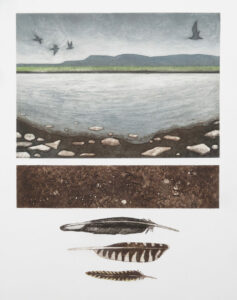
Hester: I use multiple plates in different ways. The main way is when I am building up layers of colour. I might make a ‘blank’ in the form of a varnished piece of card that I roll up with ink to make flat blocks of colour. Sometimes I blend different colours to create a graduated ‘rainbow roll’. I’ll then print a textural collagraph plate over the top of that so that the colour shows through. This can get quite complicated because I have to ‘register’ the plates to make sure they all line up and print in the right place. I also use multiple plates alongside each other. For example, I might print three separate images to create one design. Over the years I have found that I can often say more about a landscape or subject by concentrating on details and printing those details as separated areas for example in my prints, Tracks & Traces, The Watering Hole’& Crackpot Hall. Or I may print a number of individual plates side-by-side to create a linear narrative such as in my ‘Waymarks’ series. These are all separate walks or runs that I have done and I have depicted things seen along the routes so the prints tell the story of each journey. Finally, I have also made pieces where I’ve used old letter press drawers. The wooden trays have lots of separate sections and I have designed prints to be mounted onto wooden blocks that fit in each section such as in Hay Meadow. This piece has 95 separate prints and is designed to evokethe feeling of looking at a hay meadow.

Leslie: What goes into your art as a result of your fell running? What aspects of nature come into clearer focus when you run?
Hester: As far as my art is concerned, my running serves two purposes. The first is as a source of inspiration. I live in the Yorkshire Dales and it really is a beautiful landscape. I am very interested in wildlife and natural history and I can get to places that a lot of people don’t get to because I often run on small footpaths or follow wildlife or sheep tracks and I don’t mind getting wet feet in the bogs. I run throughout the year in all weathers and in the winter I often run at night using a head torch. I might be inspired by the weather and how it changes the landscape or it could be an encounter with an animal that will trigger off an idea. I carry a camera to record anything that I think might make it into a print and that helps me to remember the things that I see. The second way that my running influences my work is because I find that it really helps me when I’m trying to work out ideas or solve printmaking conundrums. There is a meditative quality to running and your thoughts become singular and clearer. As your breathing settles and your body makes the rhythmic motions, worries and preoccupations fall away and your mind is free to work in a creative way. Running lifts my mood and is the perfect antidote to days spent sat still working in my studio.
Leslie: How do you use photography, poetry and writing as part of your artistic process, please?
Hester: As I have mentioned, I use a compact camera to record things that I see on my runs. It has a powerful zoom and I take lots and lots of photos of birds and animals that I see. I have built up a comprehensive photo library that I can draw upon when I’m designing my prints. I do a lot of birdwatching so I am familiar with how the different species look and it is important to me that I get the details right in my prints so that other people recognise them too. I went through a phase where I wrote lots of haiku and I found that these had a way of distilling my thoughts and memories of my runs and walks and, in turn, would often help to inspire prints at a later date. I’m not interested in very realistic depictions of the landscape, I like to distil the essence of what I see, simplifying it and stylising it to create atmosphere. Often I’ll write notes and I have a notebook on me most of the time. This is often full of ‘to do ‘ lists but amongst those you will find the seeds of an idea or a few species of birds that I’ve seen. Things that jog my memory at a later stage.
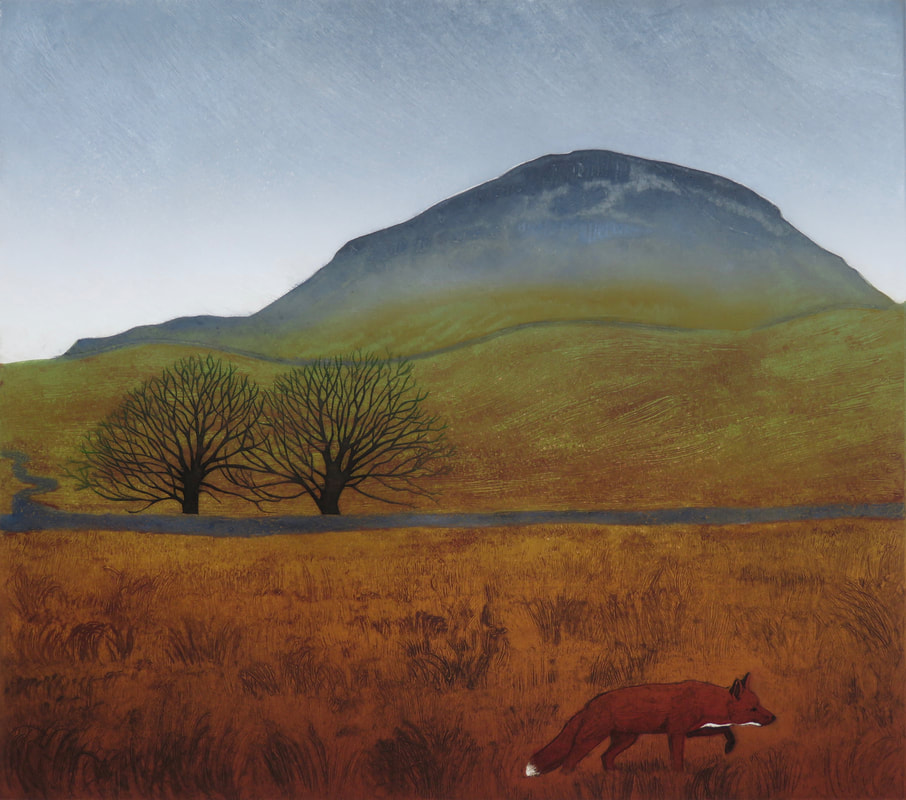
Leslie: Can you tell the story of Marie Hartley and Ella Pontefract and how you worked on their heritage. What aspects of your own art were changed/inspired by this project?
Back at the beginning of 2018 I was contacted by Fiona Rosher, Museum Manager at the Dales Countryside Museum in Hawes. The Museum was currently celebrating the 50th Anniversary of the book Life and Tradition in the Yorkshire Dales which was written by Marie Hartley and Joan Ingilby. Within their archives was a collection of 130 wood engraving blocks created by Marie Hartley MBE and Fiona wanted to know if I would be interested in printing them so that they could have a set of prints for their archive. I ended up printing up the blocks in the museum so that people could watch and ask questions and Fiona applied for funding for me to carry out my own research and make new work that was connected to Marie Hartley with a view to exhibiting it in a big exhibition two years later.
Marie Hartley was an amazing woman. She was a writer, artist, cultural historian and founder of the Dales Countryside Museum. She spent many years of her life travelling around Yorkshire collecting artefacts and talking to the people that were connected to the landscape: farmers, travellers, gamekeepers, landowners etc. She made lots of drawings of the places that she visited and the people that she met. She started her career collaborating with her friend and companion, Ella Pontefract who did the writing for the first few books although they were very much a collaborative effort. The two would travel around in a little caravan that they nicknamed The Green Plover and they would camp in farmer’s fields so that they could explore the Dales. They had a toilet tent called Lavinia which frequently got blown down and their exploits were documented in detail in Marie’s diaries. The wood engravings that Marie created were to illustrate the three books that she collaborated on with Ella. The books were called Wharfedale, Swaledale and Wensleydale and they were all about the landscape, history and people of those dales. The books are really interesting and document a way of life that has changed so much over the past years for example, traditional hay-making with horses that has been overtaken by mechanisation. They also talk about the people that lived in the places and the history. Unfortunately, Ella died when she was only 48 and, following a period of great sadness, Marie ended up collaborating with her friend Joan Ingleby on her future books and the two lived together in Askrigg. The artifacts that they collected on their travels form the basis of the museum’s collections.
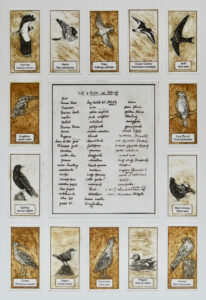
For my new work, I chose a few places that Marie and Ella wrote about in the Dales books and I visited them repeatedly throughout a calendar year. I made work about the things that I saw, the ecology of the places and the farming. I also had access to Marie’s diaries and sketchbooks from the 1930s and 40s and I used the information in these to inform my work. For example, a bird list from 1947 of all the species that Marie saw around Askrigg. That led to a piece called Marie’s List which explores the fact that many of the birds that she saw are now declining in numbers and one, the corncrake, can no longer be found in the Yorkshire Dales due to the changes in farming and the landscape.
In terms of how my work changed in response to this project, I think it helped strengthen in me the idea that I would like to create more art that is to do with ecology and conservation and work on collaborative projects with people who work with the land for example, farmers, landowners, ecology groups etc. I created a lot of the finished pieces for the exhibition, ‘The View from the Fells: In the Footsteps of Marie Hartley’, during the first lockdown. As everything closed down around me and my calendar cleared, I focussed solely on the project and my work became smaller, more intricate and reflected more deeply my concerns about the environment. Besides Marie’s List, I also created Haymeadow which consists of 95 tiny plates depicting the plants that exist in a healthy upland meadow. I designed these to fit a vintage letterpress tray, giving them the significance of artefacts but also the feel of a meadow with buttercups intermingled throughout. I spent weeks printing the plates so that gradually my studio filled with flowers. It felt positive and uplifting. I was finding solace in nature during my daily exercise and back in the studio it was also a balm. Looking at social media, I was seeing so many people talking about the wildlife they were noticing, the birds in their gardens and the way they were finding comfort in nature. This gives me hope in these times of climate change, loss of species and threats to natural habitats. I want to celebrate our fragile natural world through my work and help people to connect with the landscape so that more and more fight to protect it.

Leslie: Why do you use strong colours in your art?
Hester: Colours trigger moods and blocks or layers of colour can be used as an artistic shorthand for different times of the day or season. I use colour to help accentuate my ideas. I am drawn to contrasting colours in the landscape and patches of shadow and sunlight will change what you’re looking at dramatically. I’m drawn to small splashes of colour in a monochrome landscape for example, a red fox against the snow or a bright blue kingfisher against a green river bank. I’m currently slightly obsessed by the black traceries of winter trees and flights of birds against dramatic coloured skies. I occasionally work in black and white only but there is so much colour in the natural landscape and I do like to celebrate that. I’ve been told by customers that they find my prints joyful and I think the colour plays a big part in that.
Next week’s interview is with prolific Nigerian poet and editor Adedayo Agarau who was a finalist in the 2021 Sillerman Prize.
ABOUT LESLIE TATE’S BOOKS:

I interviewed poet & artist Jane Burn who won the Michael Marks Environmental Poet of the Year 2023-24 with A Thousand Miles from the Sea.

I interviewed ex-broadcaster and poet Polly Oliver about oral and visual poetry, her compositional methods, and learning the Welsh language. Polly says, “I absolutely love

I interviewed Jo Howell who says about herself: “I’ve been a professional photographic artist since I left Uni in 2009. I am a cyanotype specialist.


Poet Tracey Rhys, writer of Teaching a Bird to Sing and winner of the Poetry Archive’s video competition reviews Ways To Be Equally Human. Tracey,
| Cookie | Duration | Description |
|---|---|---|
| cookielawinfo-checkbox-analytics | 11 months | This cookie is set by GDPR Cookie Consent plugin. The cookie is used to store the user consent for the cookies in the category "Analytics". |
| cookielawinfo-checkbox-functional | 11 months | The cookie is set by GDPR cookie consent to record the user consent for the cookies in the category "Functional". |
| cookielawinfo-checkbox-necessary | 11 months | This cookie is set by GDPR Cookie Consent plugin. The cookies is used to store the user consent for the cookies in the category "Necessary". |
| cookielawinfo-checkbox-others | 11 months | This cookie is set by GDPR Cookie Consent plugin. The cookie is used to store the user consent for the cookies in the category "Other. |
| cookielawinfo-checkbox-performance | 11 months | This cookie is set by GDPR Cookie Consent plugin. The cookie is used to store the user consent for the cookies in the category "Performance". |
| viewed_cookie_policy | 11 months | The cookie is set by the GDPR Cookie Consent plugin and is used to store whether or not user has consented to the use of cookies. It does not store any personal data. |